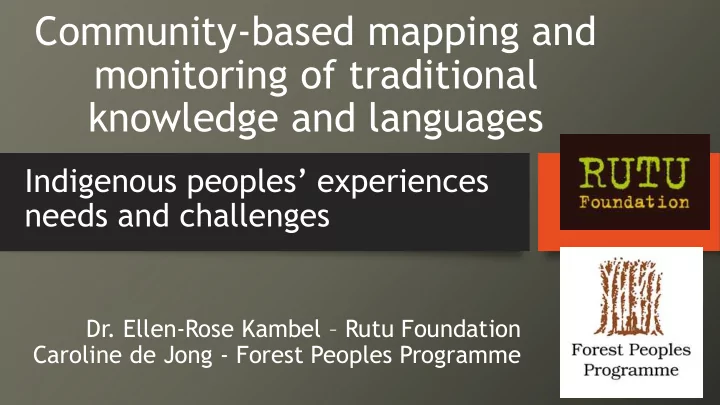

Community-based mapping and monitoring of traditional knowledge and languages Indigenous peoples’ experiences needs and challenges Dr. Ellen-Rose Kambel – Rutu Foundation Caroline de Jong - Forest Peoples Programme
Introduction
Overview presentation: • Data on indigenous and local communities well-being • Advances in land and resource data gathering and monitoring • Examples of community based mapping • Challenges encountered • The need for community based language mapping • Example from Suriname • Why indigenous languages and knowledge matter A tool for mapping and monitoring indigenous knowledge and languages?
Data on Indigenous Peoples and Local Communities’ ( IPLCs) well-being
Background: • IPLCs and their situations and contributions and knowledge are increasingly recognised in the Global Change Agendas • But: these often lack information on IPLCs • IPLCs have been largely invisible in maps and in global data. • Lack of info on IPLCS in national statistics • Challenges and goal: bringing their stories together and make the situation and visible to the world • Need for comparability between various data being gathered – move beyond ‘case studies.
Background • IPLCs have recognised that they need to lead on this themselves and do the work Community-based data collection and monitoring and developing indicators for indigenous well-being • Information is serving many purposes and deployed at various levels “We ourselves have told them the status of IPs in the countries needs to be included. The states do not have the data, nor the capacity to gather that data. So the solution is that communities will gather the data themselves.” – Joji Cariño (member of IPMG).
Advances in land and resource data gathering and monitoring & Examples of community based mapping • Monitoring based on traditional knowledge with the use of ‘new technologies’ • For instance, GIS/GPS, satellite imagery, or drone images • Helps to support communities to better understand and document change and impacts to their territories • visualise impacts of (illegal) activities like mining, logging, land degradation or land use change, land grabbing and other impacts, • not only for external audiences but also for raising awareness within communities.
Territorial mapping by Wapichan people, Guyana
ECO-CULTURAL MAPPING (Eco-cultural calendar) Kenya
Indonesia: mapping customary lands and palm oil concessions
Community-Based Monitoring Pilots in Cameroon Objectives: • Monitor agro-industrial concessions, logging, mining • Increase access and usage rights for communities in protected areas
Data collection: Community monitors use smartphones to document issues (photo, GPS point, time, notes…) Data aggregation: Community associations use laptops to aggregate the monitoring findings from the smartphones
Monitoring maps
Some of the gains and benefits: • Empowering process which promotes community involvement and sense of community ownership • Culturally appropriate approaches and tools better reflect indigenous world vision than ‘western maps’ . • Data and outcome products are useful for communities’ own land use and governance planning, tenure advocacy and as evidence for their territorial claims • Mapping and monitoring can contribute to inter-generational knowledge transmission, but also to public education or the teaching of outsiders.
Some of the challenges: • Recording the ‘what, where, when’, involves wide community participation but in systematizing the data, and generation of monitoring reports, participation is usually more limited as often computers and specialised knowledge are used. • Many tools that work with questionnaires, like GeoODK collect, are difficult or impossible to use for people who are not literate • Challenge of need to be able to enter information offline. • Many technologies require electricity – not available in all communities. • Technology could undermine Traditional Knowledge and create a disconnect. • It is challenging to connect up different technologies. • Introducing technology in communities can increase imbalances: e.g. education levels, gender, between generations.
Some of the needs and wishes: • Be able to record and reflect data that provides insight in trends and changes over time (for example, ammoniac content of water) and collecting data on issues not necessarily linked to a part of the territory (e.g. on language or knowledge status). • The applications currently are very focussed on spatial information.
The need for community based language mapping
knowledge = language
Why do indigenous knowledge and language matter?
To adapt to changes
Water
Transportation
Housing
Food
To heal indigenous youth
To preserve species, foods, medicine
What we did in Suriname
Indigenous Education Festival
Training Teachers in Culturally Appropriate Education
Bilingual Culturally Relevant Education Material
Language Survey
Constraints • Communities unable to analyse data themselves • Collaboration with university means risk losing control, how will data be used?
Question: can we adapt and use tools for mapping and monitoring lands and resources for measuring trends in language and traditional knowledge?
Goals of tool: • For internal use: monitoring well-being of people and environment • For external use: advocating for indigenous rights at national and international level
Tools must be: A. Accessible for communities who don’t all have access to higher education, internet, electricity B. Replicable: able to measure trends over time C. Compatible and comparable D. Affordable: available at low cost (open source, free, or bespoke tools?)
Thank you! Caroline de Jong Dr. Ellen-Rose Kambel Environmental Governance Coordinator, director Rutu Foundation Forest Peoples Programme ellen-rose@rutufoundation.org caroline@forestpeoples.org www.rutufoundation.org www.forestpeoples.org
Recommend
More recommend